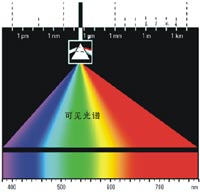Copy of color in printing (top)
Color Classification
The colors in the image can be divided into two categories, achromatic and color. Achromatic is black, white, and all kinds of gray from black to white. They can be arranged in a series called black and white series. The change from black to white in the series can be represented by a gray band. Pure black, the other end is pure white. The achromatic color of the black and white series can only reflect the change in the light reflectance of the substance, and the visual sensation is a bright change. When the surface of the print has a reflectance of 80% to 90% of the radiation of all wavelengths in the visible spectrum, the visual sensation is white. If the reflectance is less than 4%, it is black. White, black, and gray objects are not selective for reflections at each wavelength of the spectrum, and they are called neutral gray. Colors other than black and white series are called color. Any color is represented by three quantities: hue, brightness, and saturation.
Hue is the most basic feature of color. People call colors such as red, yellow, and green according to hue. Hue is determined by the color of light reflected from the surface of the object to the optic nerve of the human eye. The monochromatic light can be determined by the wavelength of its light. If the color of the light composition is mixed, the hue is determined by the ratio of the light amounts of the various wavelengths of the mixed light. For example, in sunlight, the surface of printed matter reflects colored light having a wavelength of 500-550 nm, and in comparison with absorbing other wavelengths of colored light, the visual impression of the printed product is green.
Photometrically, the brightness of a color is described as the value of light (ie, the energy of light), which can be measured with a photometer. It is generally believed that the reflectance of the surface of a color object is high, and the brightness of the color object is larger.
Saturation (also called chroma) refers to the purity of color, and the various colors of monochromatic light in visible light are the most saturated colors. The more the white light component incorporated by the spectral color, the less saturated. The saturation of the object's color depends on the selectivity of the reflection spectrum of the surface of the object. The object has a high reflectivity in a narrow band of the spectrum, and the reflectivity of other wavelengths is low or there is no reflection. The saturation of this color is high.
The formation of color
The formation of any color is related to light, that is, there is a relationship between light and color. At the same time, the human eye must see a certain color, and it must also have four major elements.
There is a relationship between light and color
The formation of color is inseparable from light. It is because of the existence of light that we can recognize color. The light is an electromagnetic wave, and part of the electromagnetic wave is invisible to the human eye, and the other part of the electromagnetic wave is visible to the human eye. We call it visible light with a wavelength range of 380 nm to 780 nm. Normally when we see visible light combined together, it is white light.

Four elements
As far as all colors of nature are concerned, we can classify them into two types. One is the luminescent color, which is the color formed by the light emitted by the object itself after it enters the human eye; the other is the color of the object, the color of this type. The color must be perceived only when white light strikes the surface. In other words, the formation of such colors must include light sources, colored objects, eyes, and four major elements of the brain, and they are indispensable. For example, when we sense the colors on prints, we must first have the light shine on the surface of the prints, and then selectively modulate the light through the surface of the prints. The modulated light is then reflected back into the human eye to produce an optic nerve impulse to the incoming brain from the brain. Form color.
